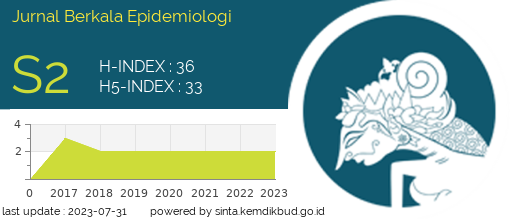HIGH-RISK INTERNET ADDICTION IN ADOLESCENTS DURING PANDEMIC COVID-19 AND PARENTS' ROLE
Downloads
Background: The use of smartphones among adolescents has been increasing during the COVID-19 pandemic, especially using the internet daily, because adolescents do not have physical activities during the lockdown. Using the internet for doing assignments from school, using social media as a substitute for meeting with their friends directly, introducing new people and the internet for entertainment such as playing the game online, listening to music or watching a film. Purpose: This literature aimed to study the risk of internet addiction in adolescents during the COVID-19 pandemic and know parents' role to accompany adolescents while using the internet daily. Methods: A review of articles on internet use in adolescents during the pandemic was done to determine the risk of internet addiction. This article included article review, systematic review, research journals, qualitative and quantitative methods, and books. Meanwhile, the exclusion journals were not in English. The search of journals accessed from Google Scholar, Pubmed, and Science Direct with keywords ‘adolescents', ‘internet addiction', ‘parenting', ‘education' and ‘COVID-19'. Results: Internet use has been increasing during the COVID-19 pandemic and is at risk of causing addiction to adolescents. Unattended use of the internet and time restrictions from parents are at risk of causing internet addiction in adolescents. Conclusion: Internet use has been increasing during the COVID-19 pandemic and is at risk of causing addiction in adolescents. Time restriction and parental supervision are needed for adolescents to use the internet daily.
American Psychiatric Association. (2013). Diagnostic and statistical manual of mental disorders (DSM-5®) (Fifth edition). Washington D.C: American Psychiatric Association Publishing.
Ayar, D., Bektas, M., Bektas, I., Akdeniz Kudubes, A., Selekoglu Ok, Y., Sal Altan, S., & Celik, I. (2017). The effect of adolescents' internet addiction on smartphone addiction. Journal of Addictions Nursing, 28(4), 210–214. https://doi.org/10.1097/JAN.0000000000000196
Bener, A., Yildirim, E., Torun, P., Çatan, F., Bolat, E., Alıç, S., ... Griffiths, M. D. (2019). Internet addiction, fatigue, and sleep problems among adolescent students: a large-scale study. International Journal of Mental Health and Addiction, 17(4), 959–969. https://doi.org/10.1007/s11469-018-9937-1
Cao, W., Fang, Z., Hou, G., Han, M., Xu, X., Dong, J., & Zheng, J. (2020). The psychological impact of the COVID-19 epidemic on college students in China. Psychiatry Research, 287, 1–5. https://doi.org/10.1016/j.psychres.2020.112934
Chasanah, A. M., & Kilis, G. (2018). Adolescents' gadget addiction and family functioning. Universitas Indonesia International Psychology Symposium for Undergraduate Research (UIPSUR 2017), 139, 350–358. Atlantis Press. https://doi.org/10.2991/uipsur-17.2018.52
Cho, E., & Reuter, M. (2017). Internet addiction: studies in neuroscience, psychology and behavioral economics (Second edition). Switzerland: Springer International Publishing Switzerland.
Frahasini, F., Astuti, T. M. P., & Atmaja, H. T. (2018). The impact of the use of gadgets in school of school age towards children's social behavior in Semata Village. Journal of Educational Social Studies, 7(2), 161–168. https://doi.org/10.15294 /jess.v7i2.26842
Kurniasanti, K. S., Assandi, P., Ismail, R. I., Nasrun, M. W. S., & Wiguna, T. (2019). Internet addiction: a new addiction? Medical Journal of Indonesia, 28(1), 82–91. https://doi.org/10.13181/mji.v28i1.2752
Li, D., Li, X., Zhao, L., Zhou, Y., Sun, W., & Wang, Y. (2017). Linking multiple risk exposure profiles with adolescent internet addiction: insights from the person-centered approach. Computers in Human Behavior, 75, 236–244. https://doi.org/10.1016/j.chb.2017.04.063
Malak, M. Z., Khalifeh, A. H., & Shuhaiber, A. H. (2017). Prevalence of internet addiction and associated risk factors in Jordanian school students. Computers in Human Behavior, 70, 556–563. https://doi.org/10.1016/j.chb.2017.01.011
Müller, K. W., Dreier, M., Beutel, M. E., Duven, E., Giralt, S., & Wölfling, K. (2016). A hidden type of internet addiction? intense and addictive use of social networking sites in adolescents. Computers in Human Behavior, 55(PA), 172–177. https://doi.org/10.1016/j.chb.2015.09.007
Rich, M., Tsappis, M., Kavanaugh, J. ., Shin, Y. M., Leung, L., Zhang, R., ... Hancock, M. (2017). Internet addiction in children and adolescents: risk factors, assessment, and treatment (First edition.; K. S. Young & C. N. de Abreu, eds.). New York: Springer Publishing Company. https://doi.org/10.1891/9780826133731
Rosyati, T., Purwanto, M. R., Gumelar, G., Yulianti, R. T., & Mukharrom, T. (2020). Effects of games and how parents overcome addiction to children. Journal of Critical Reviews, 7(1), 65–67. https://doi.org/10.22159/jcr.07.01.12
Solinas, M., Belujon, P., Fernagut, P. O., Jaber, M., & Thiriet, N. (2019). Dopamine and addiction: what have we learned from 40 years of research. Journal of Neural Transmission, 126(4), 481–516. https://doi.org/10.1007/s00702-018-1957-2
Sun, Y., Li, Y., Bao, Y., Meng, S., Sun, Y., Schumann, G., ... Shi, J. (2020). Brief report: increased addictive internet and substance use behavior during the Covid-19 pandemic in China. The American Journal on Addictions, 29(4), 268–270. https://doi.org/10.1111/ajad.13066
Sussman, C. J., Harper, J. M., Stahl, J. L., & Weigle, P. (2018). Internet and video game addictions: diagnosis, epidemiology, and neurobiology. Child and Adolescent Psychiatric Clinics of North America, 27(2), 307–326. https://doi.org/10.1016/j.chc.2017.11.015
VondráÄková, P., & Gabrhelík, R. (2016). Prevention of internet addiction: a systematic review. Journal of Behavioral Addictions, 5(4), 568–579. https://doi.org/10.1556/2006.5.2016.085
WÄ…siÅ„ski, A., & Tomczyk, Å. (2015). Factors reducing the risk of internet addiction in young people in their home environment. Children and Youth Services Review, 57, 68–74. https://doi.org/10.1016/j.childyouth.2015.07.022
Wegmann, E., Stodt, B., & Brand, M. (2015). Addictive use of social networking sites can be explained by the interaction of Internet use expectancies, Internet literacy, and psychopathological symptoms. Journal of Behavioral Addictions, 4(3), 155–162. https://doi.org/10.1556/2006.4.2015.021
Young, K. S. (2017). The evolution of internet addiction. Addictive Behaviors, 64, 229–230. https://doi.org/10.1016/j.addbeh.2015.05.016
- Every manuscript submitted to must observe the policy and terms set by the Jurnal Berkala Epidemiologi
- Publication rights to manuscript content published by the Jurnal Berkala Epidemiologi is owned by the journal with the consent and approval of the author(s) concerned. (download copyright agreement)
- Complete texts of electronically published manuscripts can be accessed free of charge if used for educational and research purposes according to copyright regulations.

JBE by Universitas Airlangga is licensed under a Creative Commons Attribution-ShareAlike 4.0 International License.























